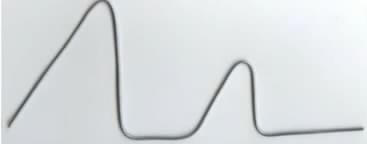Assignment Project 1: Structural responses of an arbitrary wire
Problem Specification:
A wire shape is to be manufactured from the provided length of drawn wire, an example of a bent wire is shown in Figure 1. The structure should then be used to experimentally solve a force- displacement problem, followed by the calculation of the natural modes of vibration of the structure (with one fixed-support).
Analytical and numerical (Finite Element) calculations for the force-displacement and vibration problems should be presented.
An analysis and discussion of the results should be given with particular focus on any differences between approaches and a discussion of the accuracy of the results due to assumptions associated with each method.

Figure 1 Example piece of bent wire
Presentation:
A prescribed format for your assignment is provided. The template can be downloaded from Cloud Deakin. This is similar to how you would receive a prescribed format if you writing a report in an engineering firm or submitting a research paper to a Journal or Conference. It is an important skill to be able to accurately follow a prescribed format.
Relevant ABAQUS input (.inp) and data (.dat) files must be uploaded in the appropriate section on CloudDeakin. See the template document for more information on the file naming convention.
Your report should contain a photograph with the wire dimensions clearly indicated.
Length: max. 8 pages
Task summary:
Question 1: Experimentally measure the elastic modulus of the wire
a. Fix one end of the structure to a solid base (e.g., clamp one end to a desk).
b. Add a known load to the wire. Small denomination coins (eg. 2c, 5c, 10c) can be useful for this purpose.
What assumptions are made when deriving the flexure formula for beams? How do these assumptions relate to your problem?
c. Calculate Young's modulus of the material. You know the moments of inertia from geometry, you can calculate the displacement under a known load, and then solve for 'E' (this is much easier to calculate with a straight piece of wire!).
Question 2: Bend the wire into a unique shape, consisting of only straight sections (i.e., no curves). Full marks cannot be awarded for simple shapes. As a rule you should bend the wire a minimum of 5 times. No two students should have exactly the same wire shape.
You should experimentally determine the following (for the bent wire):
a. The displacement of the structure when your structure is clamped at one end (fixed boundary conditions) and loaded at the opposite end with a known load.
b. Vibration frequency of the first mode of vibration of:
i. Just the wire, and
ii. Wire with a concentrated mass attached
Question 3: Using ABAQUS solve the following problems numerically (for the bent wire):
a. Vibration frequency of the first mode of vibration of:
i. Just the wire, and
ii. Wire with a concentrated mass attached
b. Displacement of the structure when loaded at the opposite end with a known load.
Question 4: Using your brain and a pen, solve the following problems analytically (for the bent wire):
a. Vibration frequency of the first mode (ball-park figure required only) of:
i. Just the wire, and
ii. Wire with a concentrated mass attached
b. Displacement of the structure when loaded at the opposite end with a known load (exact solution or ball-park answer can be provided. It will be marked accordingly).
Some advice
1. This is a Finite Element course. Focus on your FE model and results.
2. Use the marking rubric to plan your report. This is what is used to grade your submission.
3. ALWAYS clearly state all of your assumptions - this demonstrates a clear understanding of the limitations of your experimental, numerical and analytical procedures.
4. Do not use the Finite Element Method for your hand-calculations (do not assemble the stiffness matrix. This is what ABAQUS is doing!). You should use analytical methods that you have been taught in your undergraduate studies. You should not derive anything from first principles.
5. Reference all equations, regardless of their simplicity.
6. The natural modes of vibration of your structure will have high damping. You should discuss the implications of this on your results.
7. Be efficient by solving your analytical equations by hand with pen and paper. For longer calculations you can scan your workings and attach to the end of your report as an appendix (remember there is a page limit!).
8. Present your ideas and solutions logically and clearly.
9. You do not need to book the lab! (Don't laugh, people have done it before). Everything can, and should be, done at home with your own equipment.
It is always advisable to take online assistance from the professionals of CAE and Finite Element Analysis Assignment Help service for securing better academic results.
Tags: CAE and Finite Element Analysis Assignment Help, CAE and Finite Element Analysis Homework Help, CAE and Finite Element Analysis Coursework, CAE and Finite Element Analysis Solved Assignments
Attachment:- Structural responses of an arbitrary wire.rar